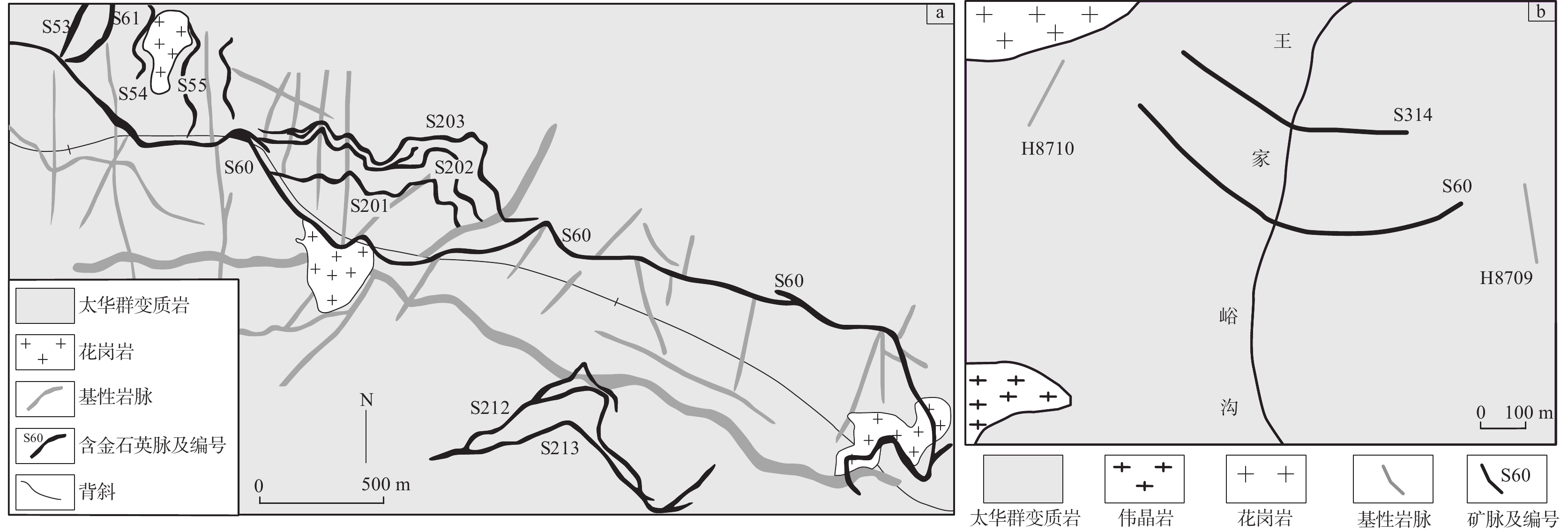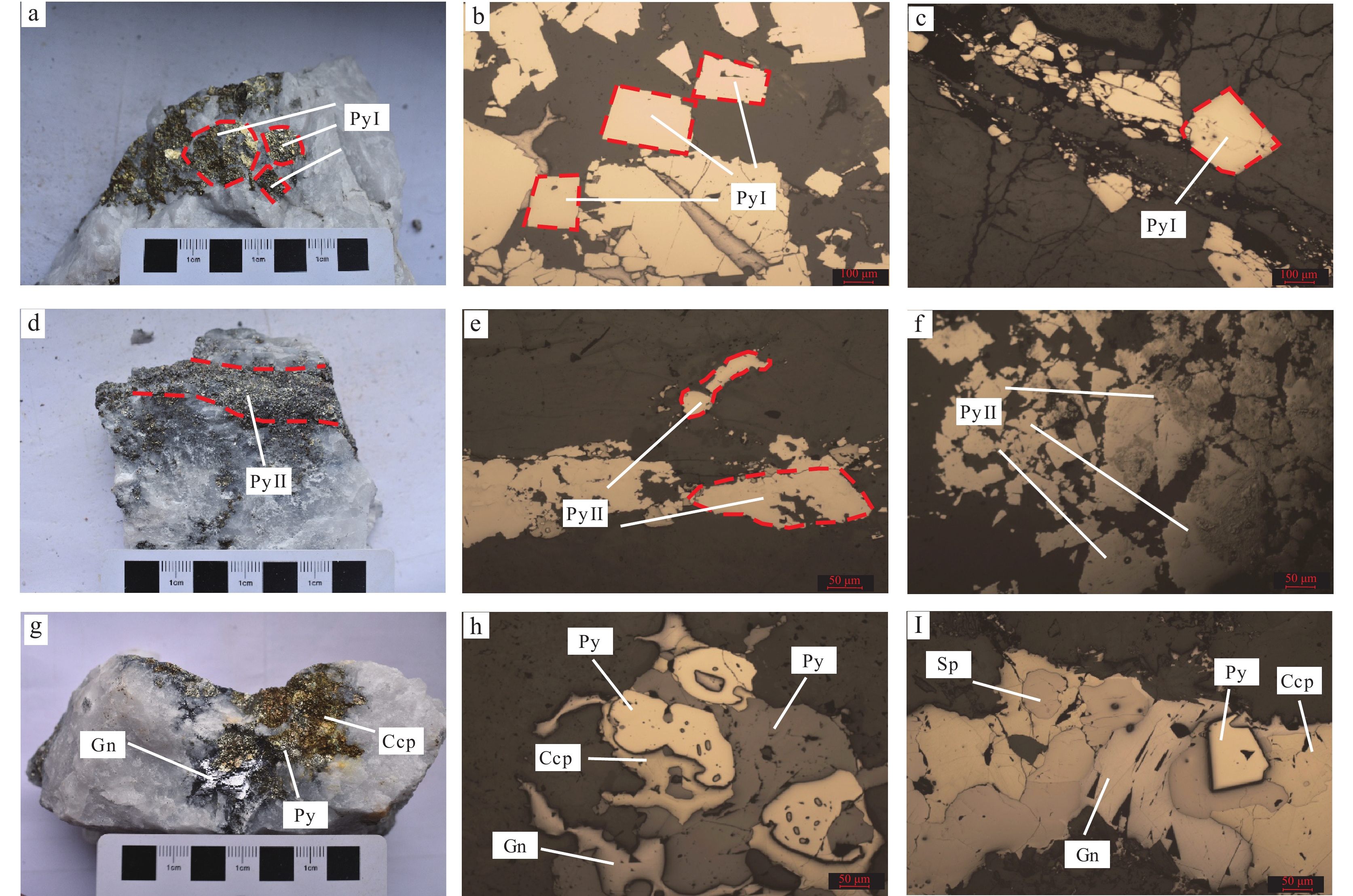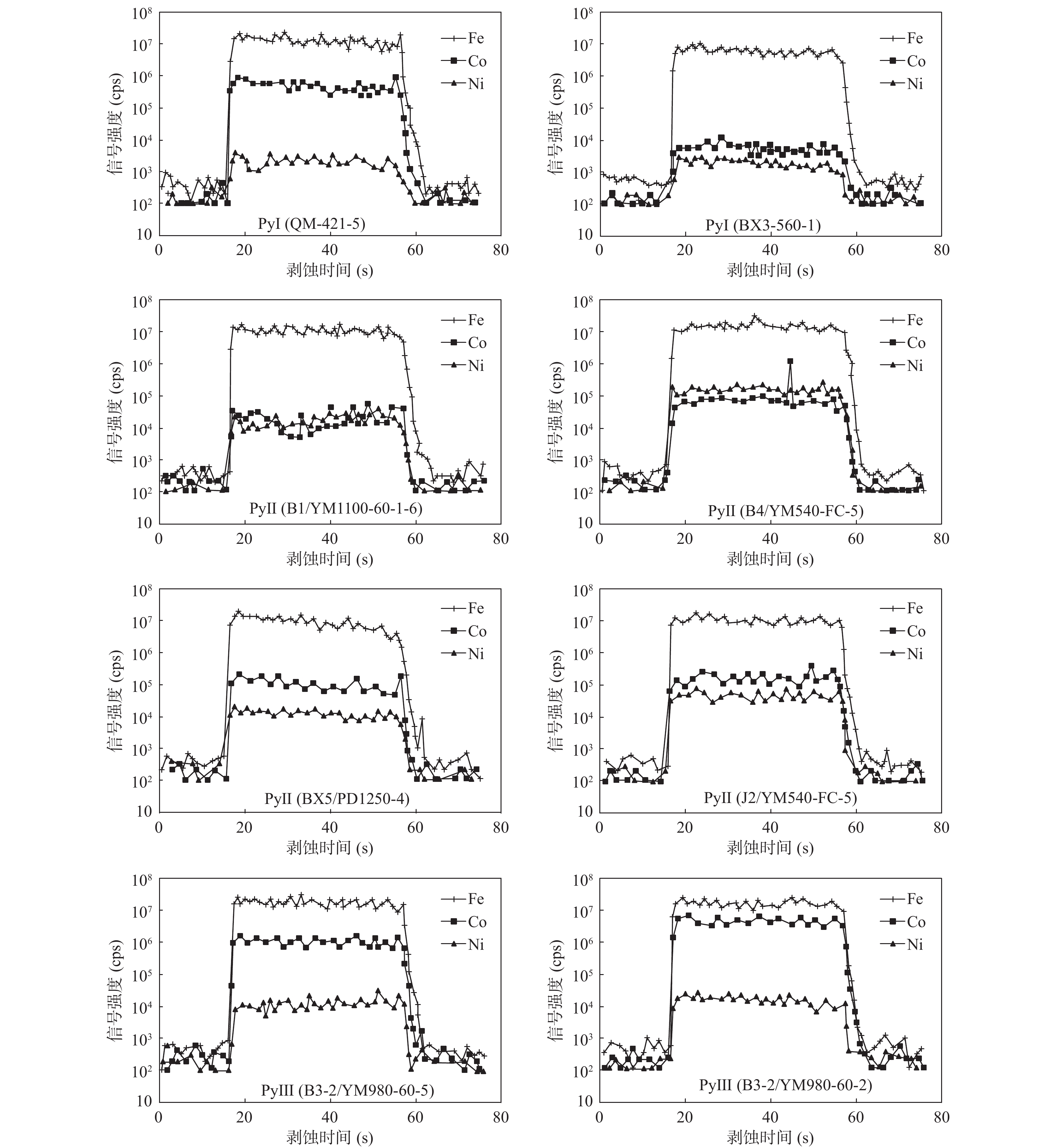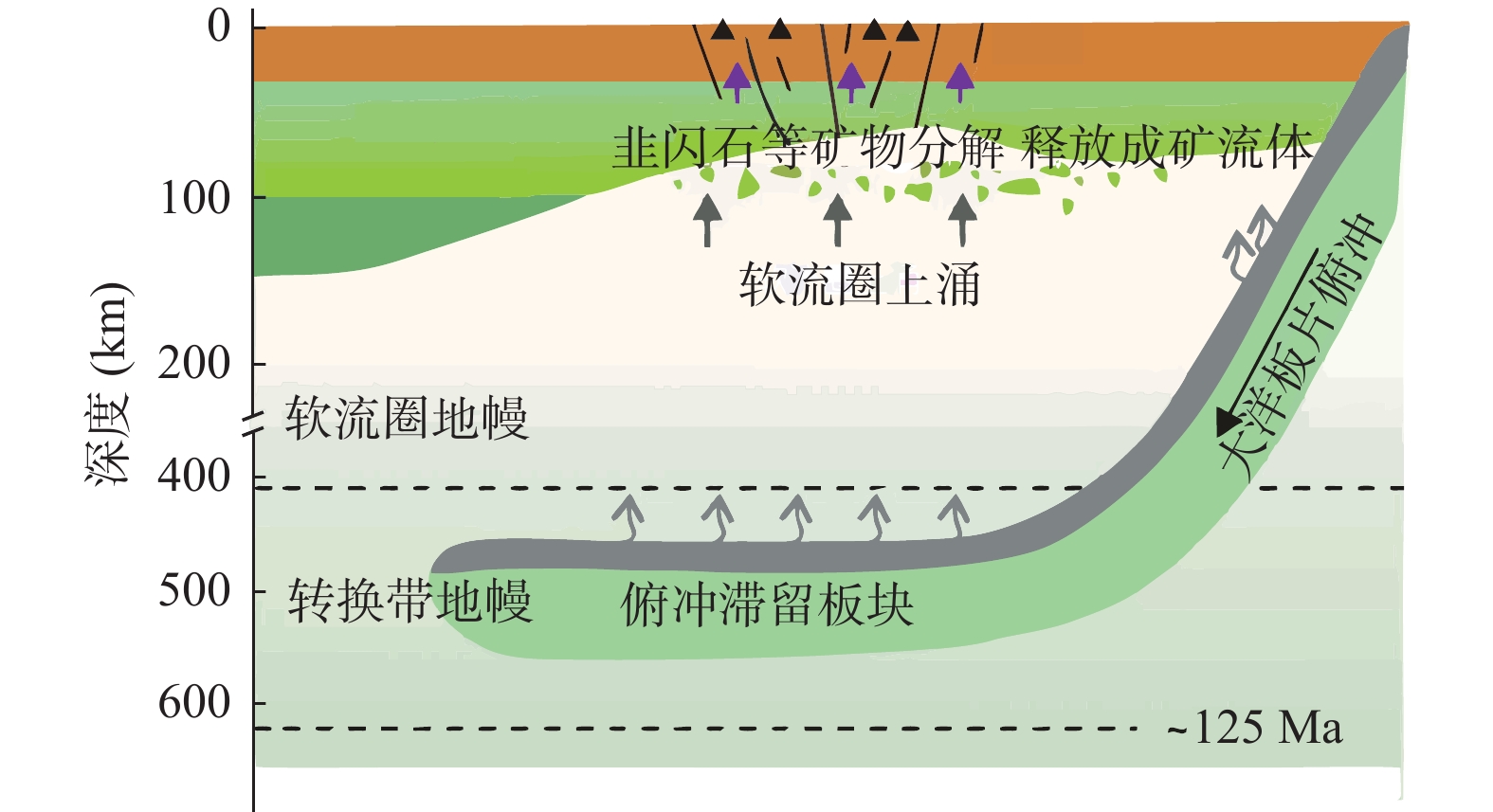LA-ICP-MS In-situ Trace Element Characteristic of Pyrite from Yangzaiyu-Fancha Ore Block in Xiaoqinling Gold Field and Its Indication
-
摘要:
小秦岭金矿田位于华北克拉通南缘,目前探明金储量611 t。前人对该区金矿床做了大量科研工作,但区内金矿的成矿地质背景与成矿物质来源仍存在较大的争议。笔者以小秦岭金矿田南中矿带杨砦峪、樊岔金矿床S60矿脉中黄铁矿为研究对象,通过细致的野外观察与镜下鉴定,将黄铁矿从早到晚分为3个世代,并对不同世代的黄铁矿进行LA-ICP-MS微量元素分析,取得认识如下:不同世代黄铁矿中Au、Ag、Te、As、Co、Ni等微量元素的含量及其分布特征具有较显著的差异性,各个世代黄铁矿中As的含量均很低,暗示该区金矿床的形成与As无关;第2世代黄铁矿中Au与Te尤为富集且两者存在显著和稳定的线性正相关关系,指示该世代为金矿床形成重要阶段,并且Te元素在成矿过程中对Au的搬运、富集、沉淀等过程具有重要作用;S60矿脉中普遍发育Te-Au-Ag矿物,并且黄铁矿中呈现低As、高Te特征,暗示小秦岭金矿床的成矿流体、成矿物质可能来自深部岩浆的脱挥发分或地幔脱气作用,小秦岭地区成矿地质背景与早白垩世华北克拉通破坏有关。
Abstract:Located in the southern margin of the North China Craton, the Xiaoqinling gold field has a proven gold reserve of over 611t. Although most gold deposits have been extensively studied, issues related to the metallogenic geological background and the source of the ore materials remain debated. This paper conduct further studies on the Yangzhaiyu-Fancha S60 vein of sothern-medium ore belt from Xiaoqinling gold field. Three generations of (PyⅠ, PyⅡ, PyⅢ) were identified according to detailed field investigation and microscopic identification. We presents a study of the distribution characteristics of trace elements in gold-bearing pyrite from different generation, The results show that the contents and trace element distribution characteristics of Au, Ag, Te, As, Co, Ni from different generation assum significant difference, the content of pyrite from different generation is lightly lower, and plays an insignificant role in gold mineralization; There is prominently positive correlation relationship between Au and Te in the second generation and the contents of Au, Te are relatively higher, it shows that the second generation is important for gold mineralization and the Te play an important role in transfer enrichment and precipitation of gold. An intimate Te-Au-Ag association has been widely noticed in widespread gold mineralization in Xiaoqinling gold district, and low-As, high-Te in pyrite, suggesting that the ore-forming materials and ore-forming fluids of the gold deposits may have come from the deep magma devolatilization or mantle degassing, the geogical background of the gold deposit mainly due to the destruction of the North China Craton.
-
Key words:
- pyrite /
- LA-ICP-MS /
- trace element /
- S60 vein /
- southern-medium ore belt /
- Xiaoqinling
-

-
图 1 小秦岭金矿带地质图(王雷,2018)
Figure 1.
图 2 杨砦峪矿区地质图(a)(据Jian et al., 2014)与樊岔矿区地质图(b)(据展恩鹏等,2019)
Figure 2.
图 9 克拉通破坏型金矿成矿模式图(朱日祥,2021)
Figure 9.
表 1 小秦岭南中矿带S60矿脉不同世代黄铁矿LA-ICP-MS微量元素(10−6)分析结果
Table 1. Trace elements analysis(10−6) for different generation pyrites of S60 vein from southern-medium ore belt of Xiaoqinling
样品编号 黄铁矿世代 微量元素含量 Au Ag As Te Co Ni B3/YM810-16-5 PyⅠ 0.289 0.261 0.000 3.008 51.065 10.156 B4/ym860-3 PyⅠ 0.125 0.898 0.375 0.589 172.563 102.110 B1-2/ym980-60-1 PyⅠ 0.064 1.352 0.000 6.772 0.165 5.593 B1/YM1100-60-1-4 PyⅠ 0.027 0.000 1.290 0.174 0.000 1.170 B1/YM1340-706(2)-1 PyⅠ 0.026 0.023 10.510 2.143 1617.610 139.482 B3/YM810-16-1 PyⅠ 0.020 0.641 0.088 0.362 0.783 0.857 B1/YM1250-S60-2 PyⅠ 0.012 0.579 0.448 3.937 1.266 3988.748 B1/YM1250-S60-1 PyⅠ 0.009 3.165 0.000 12.774 103.671 57.349 B1/YM860-60-3 PyⅠ 0.008 2.919 0.000 0.038 46.078 161.800 B2/YM1100-60-1-1 PyⅠ 0.003 0.005 4.032 0.311 2773.345 39.256 B3/YM810-16-3 PyⅠ 0.002 1.148 0.644 22.432 10.573 2.247 B1/YM1100-60-1-5 PyⅠ 0.001 0.003 0.722 0.368 0.026 0.923 B3/YM1220-6'-2 PyⅠ 0.000 0.005 12.879 0.185 30.398 559.956 B1/YM860-60-4 PyⅠ 0.000 0.014 8.301 0.000 1215.701 17.754 B1/YM860-60-8 PyⅠ 0.000 0.003 2.407 0.152 370.177 28.096 B1/YM1100-60-1-1 PyⅠ 0.000 0.190 0.223 0.246 5.428 13.462 B1/YM1100-60-1-2 PyⅠ 0.000 0.802 0.010 0.455 1.076 35.580 B1/YM1100-60-1-3 PyⅠ 0.000 0.030 0.328 0.028 1.535 89.319 B1/YM1340-706(2)-2 PyⅠ 0.000 0.120 8.599 0.676 1361.614 56.775 B2/YM1100-60-1-4 PyⅠ 0.000 0.000 2.408 0.052 116.124 38.612 B2/YM1100-60-1-5 PyⅠ 0.000 0.047 2.206 0.120 183.658 15.761 J1/YM1140(1)-2 PyⅠ 0.000 4.355 9.233 0.001 0.017 3.220 J1/YM1140(1)-3 PyⅠ 0.000 4.045 10.151 0.000 0.018 3.984 B1/ym730-2 PyⅡ 36.922 153.509 0.265 44.136 156.506 158.765 B1/YM1100-60-1-6 PyⅡ 22.339 189.304 1.050 1949.083 21.412 94.730 B2/YM1100-60-1-2 PyⅡ 0.031 0.000 6.444 0.314 10.712 367.962 B1/ym860-1 PyⅡ 0.114 0.076 0.218 0.824 211.179 248.814 B4/YM540-FC-5 PyⅡ 284.940 218.853 0.258 477.787 56.877 628.359 J2/YM540-FC(2)-1 PyⅡ 129.061 316.858 0.157 21182.135 5.084 11.049 J2/YM540-FC(2)-5 PyⅡ 56.407 164.167 1.608 867.542 155.490 286.144 B4/YM540-FC-6 PyⅡ 12.492 22.570 0.219 87.628 8.755 199.259 B4/YM540-FC-1 PyⅡ 4.139 3.626 0.029 20.804 109.985 169.994 B1/YM1250-S60-5 PyⅢ 0.143 7.555 0.081 25.553 103.771 387.159 J1/YM1140(1)-1 PyⅢ 0.072 19.842 351.868 1.610 0.180 13.184 B1/YM1340-706-6 PyⅢ 0.052 0.119 0.357 9.325 7.543 181.415 B2-1/YM800-60-6 PyⅢ 0.047 0.263 0.000 0.436 0.560 175.172 B3/YM1220-6'-4 PyⅢ 0.040 0.161 5.777 0.526 21.375 215.513 B2-1/YM800-60-4 PyⅢ 0.031 0.071 4.224 0.850 968.843 323.802 B3-2/YM980-60-2 PyⅢ 0.023 4.536 16.324 2.621 3047.222 49.869 B3-2/YM980-60-5 PyⅢ 0.021 3.515 2.500 0.889 726.130 43.289 J2/YM380(2)-2 PyⅢ 0.014 0.019 0.693 28.829 1718.654 220.770 B1-2/ym980-60-4 PyⅢ 0.013 0.006 0.126 0.983 0.507 28.962 B3-2/YM980-60-1 PyⅢ 0.008 0.133 6.087 1.022 457.775 27.651 B2-1/YM800-60-2 PyⅢ 0.006 0.013 0.603 0.127 521.782 119.516 B1/YM860-60-1 PyⅢ 0.000 9.886 1.501 1.127 53.225 163.838 B1/YM860-60-5 PyⅢ 0.000 3.874 0.000 23.452 55.775 243.199 B1/YM860-60-6 PyⅢ 0.000 0.458 2.063 0.489 249.658 15.994 B1/YM860-60-7 PyⅢ 0.000 0.874 1.411 0.083 28.961 150.559 B1/YM1250-S60-8 PyⅢ 0.000 0.002 0.094 0.000 49.423 374.494 B1/YM1340-706-4 PyⅢ 0.000 0.006 0.172 0.235 222.915 94.672 B2-1/YM800-60-3 PyⅢ 0.000 0.656 1.244 0.464 3.368 215.149 J2/YM540-FC(2)-7 PyⅢ 0.657 2.018 0.000 274.815 40.359 163.165 J2/YM540-FC(2)-2 PyⅢ 0.485 45.818 0.013 176.692 0.025 0.000 J2/YM380(2)-3 PyⅢ 0.034 1.573 0.542 38.064 420.350 128.781 注:0代表检测限以下,样品采自杨砦峪、樊岔金矿床;测试单位为南京聚谱检测科技有限公司。 -
[1] 毕诗健, 李占轲, 唐克非, 等. 小秦岭东桐峪金矿床黄铁矿LA-ICP-MS微量元素特征及其成矿意义[J]. 地球科学, 2016, 41(7): 1121−1140.
BI Shijian,LI Zhanke,TANG Kefei,et al. LA-ICP-MS In Situ Trace Element Analysis of Pyrite from Dongtongyu Gold Deposit and Its Metallogenic Significance,Xiaoqinling Gold District[J]. Earth Science,2016,41(7):1121−1140.
[2] 陈衍景, 郭光军, 李欣. 华北克拉通花岗绿岩地体中中生代金矿床的成矿地球动力学背景[J]. 中国科学D辑: 地球科学, 1998, 28(1): 35−40.
CHEN Yan jing,GUO Guangjun,LI Xin. Metallogenic Geodynamic Setting of Mesozoic gold deposits in granite greenstone terrane of North China Craton[J]. Science in China Series D-Earth Sciences,1998,28(1):35−40.
[3] 陈衍景. 造山型矿床、成矿模式及找矿潜力[J]. 中国地质, 2006, 33(6): 1181−1196.
CHEN Yanjing. Orogenic-type deposits and their metallogenic model and exploration potential[J]. Geological in China,2006,33(6):1181−1196.
[4] 范东旭, 夏元鹏. 小秦岭西峪-桐峪金矿矿床物质组分及金赋存状态研究[J]. 西北地质, 2023, 56(1): 254−265. doi: 10.12401/j.nwg.2022038
FAN Dongxu, XIA Yuanpeng. Material Components and Occurrence States of Gold and Silver in the Xiyu–Tongyu Gold Deposit, Xiaoqinling, Shaanxi Province[J]. Northwestern Geology,2023,56(1):254−265. doi: 10.12401/j.nwg.2022038
[5] 范宏瑞, 李兴辉, 左亚彬, 等. LA-(MC)-ICPMS和(Nano)SIMS硫化物微量元素和硫同位素原位分析与矿床形成的精细过程[J]. 岩石学报, 2018, 34(12): 3479−3496.
FAN Hongrui,LI Xinghui,ZUO Yabin,et al. In situ LA-MC-ICP-MS and (Nano) SIMS trace elements and sulfur isotope analyses on sulfides and application to confine metallogenic process of ore deposit[J]. Acta Petrologica Sinica,2018,34(12):3479−3496.
[6] 冯建之. 河南小秦岭金矿构造控矿规律及控矿模式[J]. 矿产与地质, 2009, 23(4): 302−307. doi: 10.3969/j.issn.1001-5663.2009.04.003
FENG Jianzhi. Ore-controlling structure and model in Xiaoqinling gold deposit, Henan[J]. Mineral Resources and Geology,2009,23(4):302−307. doi: 10.3969/j.issn.1001-5663.2009.04.003
[7] 高山, 章军锋, 许文良, 等. 拆沉作用与华北克拉通破坏[J]. 科学通报, 2009, 54: 1962−1973.
GAO Shan,ZHANG Junfeng,XU Wenliang,et al. Delamination and destruction of the North China Craton[J]. Chinese Science Bulletin,2009,54:1962−1973.
[8] 葛战林, 顾雪祥, 章永梅, 等. 南秦岭柞水−山阳矿集区金盆梁金矿床载金硫化物矿物学特征及成矿指示[J]. 西北地质, 2023, 56(5): 278−293. doi: 10.12401/j.nwg.2023118
GE Zhanlin, GU Xuexiang, ZHANG Yongmei, et al. Mineralogical Characteristics and Metallogenic Indication of Gold−Bearing Sulfides in the Jinpenliang Gold Deposit, Zhashui−Shanyang Ore Cluster Area, South Qinling[J]. Northwestern Geology,2023,56(5):278−293. doi: 10.12401/j.nwg.2023118
[9] 姜寒冰, 杨合群, 赵国斌, 等. 西秦岭成矿带区域成矿规律概论[J]. 西北地质, 2023, 56(2): 187−202. doi: 10.12401/j.nwg.2023012
JIANG Hanbing, YANG Hequn, ZHAO Guobin, et al. Discussion on the Metallogenic Regularity in West Qinling Metallogenic Belt, China[J]. Northwestern Geology,2023,56(2):187−202. doi: 10.12401/j.nwg.2023012
[10] 蒋少涌, 戴宝章, 姜耀辉, 等. 胶东和小秦岭: 两类不同构造环境中的造山型金矿省[J]. 岩石学报, 2009, 25(11): 2727−2738.
JIANG Shaoyong, DAI Baozhang, JIANG Yaohui, et al. Jiaodong and Xiaoqinling: two orogenic gold province formed in different tectonic settings[J]. Acta Petrological Sinica,2009,25(11):2727−2738.
[11] 李厚民, 王登红, 王晓霞, 等. 华北地块南缘熊耳山早中生代正长花岗岩——SHRIMP锆石U-Pb年龄、地球化学及意义[J]. 岩石矿物学杂志, 2012, 31(6): 771−782. doi: 10.3969/j.issn.1000-6524.2012.06.001
LI Houmin, WANG Denghong, WANG Xiaoxia, et al. The Early Mesozoic syenogranite in Xionger Mountain area, Southern margin of North China Craton: SHRIMP zircon U-Pb dating, geochemistry and its significance[J]. Acta Petrologica et Mineralogica,2012,31(6):771−782. doi: 10.3969/j.issn.1000-6524.2012.06.001
[12] 刘俊辰. 小秦岭金矿集区成矿物质来源与富集机制-以樊岔金矿床为例[D].北京: 中国地质大学(北京), 2020, 1−90.
LIU Junchen. Origins of the ore-forming materials and enrichment mechanism in the Xiaoqinling goldfield,southern margin of the North China Craton: A case study of the Fancha gold deposit[D]. Beijing: China University of Geosciences,2020,1−90.
[13] 卢欣祥, 尉向东, 董有, 等. 小秦岭—熊耳山地区金矿特征与地幔流体[M]. 北京: 地质出版社: 2004, 82−101.
LU Xinxiang, YU Xiangdong, DONG You, et al. Characteristics of Gold Deposits of Xiaoqinling-Xiongershan region and mantle fluid[M]. Beijing: Geological Publishing House, 2004, 82−101.
[14] 毛景文, 谢桂青, 张作衡, 等. 中国北方中生代大规模成矿作用的期次及其地球动力背景[J]. 岩石学报, 2005, 21(1): 169−188.
MAO Jingwen,XIE Guiqing, ZHANG Zuoheng,et al. Mesozoic Large-scale metallogenic pules in North China and corresponding geodynamic settings[J]. Acta Petrologica Sinica,2005,21(1):169−188.
[15] 邵克忠, 栾文楼. Bi-硫盐、Bi-碲化物-祁雨沟爆发-坍塌角砾岩型金矿床成因及找矿标志[J]. 河北地质学院学报, 1989, 12(3): 299−305.
SHAO Kezhong,LUAN Wenlou. Bi- Sulfosalts and Bi-Tellurides—Genetic and Exploration Criteria for the Exp1osive-Collapsed Breecia Gold Ore Deposits,Qiyugou Area[J]. Journal of Hebei College of Geology,1989,12(3):299−305.
[16] 王洁明, 董苏庆, 雷群英. 陕西金矿成矿规律与找矿靶区圈定[J]. 西北地质, 2023, 56(5): 308−321. doi: 10.12401/j.nwg.2023151
WANG Jieming, DONG Suqing, LEI Qunying. Metallogenic Regularity and Prospecting Target Delineation of Shaanxi Gold Deposit[J]. Northwestern Geology,2023,56(5):308−321. doi: 10.12401/j.nwg.2023151
[17] 王雷, 刘家军, 翟德高, 等. 小秦岭镰子沟金矿床成矿物质来源与成矿过程[J]. 地质学报, 2018, 92(2): 341−358.
WANG Lei,LIU Jiajun,ZHAI Degao,et al. Material Sources and Ore-Forming Process of the Lianzigou Gold Deposit in Xiaoqinling[J]. Acta Geological Sinica,2018,92(2):341−358.
[18] 吴桐. 小秦岭杨砦峪金矿床地球化学特征及矿床成因探讨[D]. 北京:中国地质大学(北京), 2019, 1−85.
WU Tong. Geochemical characteristics and ore genesis of the Yangzhaiyu gold deposit in Xiaoqinling district[D]. Beijing:China University of Geosciences: 2019,1−85.
[19] 杨合群, 赵国斌, 姜寒冰, 等. 西秦岭成矿带矿床成矿系列概论[J]. 西北地质, 2022, 55(1): 114−128.
YANG Hequn, ZHAO Guobin, JIANG Hanbing, et al. Discussion on the Metallogenic Series of Mineral Deposits in the Metallogenic Belt of West Qinling, China[J]. Northwestern Geology,2022,55(1):114−128.
[20] 展恩鹏, 王玭, 齐楠, 等. 河南灵宝樊岔金矿床成矿流体和同位素地球化学研究[J]. 矿床地质, 2019, 38(3): 459−478.
ZHAN EnPeng, WANG Pin, QI Nan, et al. Ore-forming fluid and isotope geochemical study of Fancha gold deposit in Lingbao County Henan Province[J]. Mineral Deposits,2019,38(3):459−478.
[21] 朱日祥, 范宏瑞, 李建威, 等. 克拉通破坏型金矿床[J]. 中国科学: 地球科学, 2015, 45(8): 1153−1168.
ZHU Rixiang,FAN Hongrui,LI Jianwei,et al. Decratonic gold deposits[J]. Science China: Earth Sciences,2015,45(8):1153−1168.
[22] 朱日祥, 孙卫东. 大地幔楔与克拉通破坏型金矿[J]. 中国科学: 地球科学, 2021, 51: 1−8.
ZHU Rixiang,SUN Weidong. The big mantle wedge and decratonic gold deposits[J]. Science China Earth Sciences,2021,51:1−8.
[23] Barton P B, Skinner B J. Sulfide Mineral Stabilities. In: Barnes, H. L., ed., Geochemistry of Hydrothermal Ore Deposits[J]. Wiley Interscience, New York, 1979, 278−403.
[24] Bi S J, Li J W, Zhou M F, et al. Gold distribution in As-deficient pyrite and Telluride minerallogy of the Yangzhaiyu gold deposit, Xiaoqinling district, southern Northern China Craton[J]. Mineralium Deposita,2011,46(8):925−941. doi: 10.1007/s00126-011-0359-2
[25] Chen L, Cheng C, Wei Z G. Seismic Evidence for Significant Lateral Variations in Lithospheric Thickness beneath the Central and Western North China Craton[J]. Earth and Planetary Science Letters,2009,286(1−2):171−183.
[26] Chen Y J , Santosh M. Triassic tectonics and mineral systems in the Qinling Orogen, central China[J]. Geological Journal,2014,49(4−5):338−358. doi: 10.1002/gj.2618
[27] Deng X, Peng T, Zhao T. Geochronology and geochemistry of the late Paleoproterozoic aluminous A-type granite in the Xiaoqinling area along the southern margin of the North China Craton: Petrogenesis and tectonic implications[J]. Precambrian Research,2016,285:127−146. doi: 10.1016/j.precamres.2016.09.013
[28] Fan H R, Hu F F, Wilde S A, et al. The Qiyugou Gold-Bearing Breccia Pipes, Xiong ershan Region, Central China: Fluid-Inclusion and Stable-Isotope Evidence for an Origin from Magmatic Fluids[J]. International Geology Review,2011,53(1):25−45.
[29] Gao S, Xu H, LI S R, et al. Hydrothermal alteration and ore-forming fluids associated with gold-tellurium mineralization in the Dongping gold deposit, China[J]. Ore Geology Reviews,2017,80:166−184. doi: 10.1016/j.oregeorev.2016.06.023
[30] Goldfarb R, Groves D I, Gardoll S. Orogenic gold and geologic time: A global synthesis[J]. Ore Geol Rev,2001,18:1−75. doi: 10.1016/S0169-1368(01)00016-6
[31] Grundler P V, Brugger J, Etschmann B E, et al. Speciation of aqueous tellurium(IV) in hydrothermal solutions and vapors, and the role of oxidized tellurium species in Te transport and gold deposition[J]. Geochimica et Cosmochimica Acta,2013,120:298−32.
[32] Jian W, Lehmann B, Mao J W, et al. Telluride and Bi-sulfosalt mineralogy of the Yangzhaiyu gold deposit, Xiaoqinling region, Central China. Canad[J]. Mineralogist,2014,52:883−898. doi: 10.3749/canmin.1400007
[33] Jian W, Mao J, Lehmann B, et al. Lingbaoite, AgTe3, a new silver telluride from the Xiaoqinling gold district, central China[J]. American Mineralogist,2020,105:745−755. doi: 10.2138/am-2020-7167
[34] Keith M, Smith D J, Jenkin G R T, et al. A review of Te and Se systematics in hydrothermal pyrite from precious metal deposits: insights into ore-forming processes[J]. Ore Geology Reviews,2018,96:269−282. doi: 10.1016/j.oregeorev.2017.07.023
[35] Li C, Li L, Li S R, et al. Late Paleoproterozoic mafic-intermediate dykes from the southern margin of the North China Craton: Implication for magma source and Columbia reconstruction[J]. Precambrian Research,2020,347:105837. doi: 10.1016/j.precamres.2020.105837
[36] Li J W, Bi S J, Selby David, et al. Giant Mesozoic gold provinces related to the destruction of the North China Craton[J]. Earth and Planetary Science Letters, 2012a, 349–350: 26–37.
[37] Li J W, Li Z K, Zhou M F, et al. The Early Cretaceous Yangzhaiyu lode gold deposit, North China Craton: A link between craton reactivation and gold veining[J]. Economic Geology,2012b,107(1):43−79. doi: 10.2113/econgeo.107.1.43
[38] Li N, Chen Y J, Santosh M, et al. Late Mesozoic granitoids in the Qinling Orogen, Central China, and tectonic significance[J]. Earth-Science Reviews,2018,182:141−173. doi: 10.1016/j.earscirev.2018.05.004
[39] Li Y, Zhu G, Su N, et al. The Xiaoqinling metamorphic core complex: A record of Early Cretaceous backarc extension along the southern part of the North China Craton[J]. GSA Bulletin,2020,132:617−637. doi: 10.1130/B35261.1
[40] Liu J, Wang Y, Huang S, et al. The gold occurrence in pyrite and Te–Bi mineralogy of the Fancha gold deposit, Xiaoqinling gold field, southern margin of the North China Craton: Implication for ore genesis[J]. Geological Journal,2020,55:5791−5811. doi: 10.1002/gj.3637
[41] Liu J C, Wang Y T, Hu Q Q, et al. Ore genesis of the Fancha gold deposit, Xiaoqinling goldfield, southern margin of the North China Craton: Constraints from pyrite Re-Os geochronology and He-Ar, in-situ S-Pb isotopes[J]. Ore Geology Reviews,2020,119:1−17.
[42] Mao J W, Wang Y T, Li H M, et al. The relationship of mantle-derived fluids to gold metallogenesis in the Jiaodong Peninsula: Evidence from D-O-C-S isotope systematics[J]. Ore Geology Reviews,2008,33:361−381. doi: 10.1016/j.oregeorev.2007.01.003
[43] Mao J W, Xie G Q, Pirajno F, et al. Late Jurassic-Early Cretaceous granitoid magmatism in Eastern Qinling, central-eastern China: SHRIMP zircon U-Pb ages and tectonic implications[J]. Australian Journal of Earth Sciences,2010,57:51−78. doi: 10.1080/08120090903416203
[44] McPhail, D. C. Thermodynamic Properties of Aqueous Tellurium Species between 25 ℃ and 350 ℃[J]. Geochimica et Cosmochimica Acta,1995,59(5):851−866.
[45] Reich M, Kesler S E, Utsunomiya S, et al. Solubility of Gold in Arsenian Pyrite[J]. Geochimica et Cosmochimica Acta,2005,69(11):2781−2796. doi: 10.1016/j.gca.2005.01.011
[46] Robert F, Poulsen K H, Cassidy K F, et al. Gold metallogeny of the Superior and Yilgarn cratons. Bull Soc Econom Geol[J]. One Hundredth Anniversary, 1905–2005: 1001–1033.
[47] Wang P, Mao J W, Ye H S, et al. The Qiyugou Au orefield — An intrusion-related gold system in the Eastern Qinling ore belt, China: Constraints from SIMS zircon U-Pb, molybdenite Re-Os, sericite 40Ar-39Ar geochronology, in-situ S-Pb isotopes, and mineralogy[J]. Ore Geology Reviews,2020,124:103636.
-



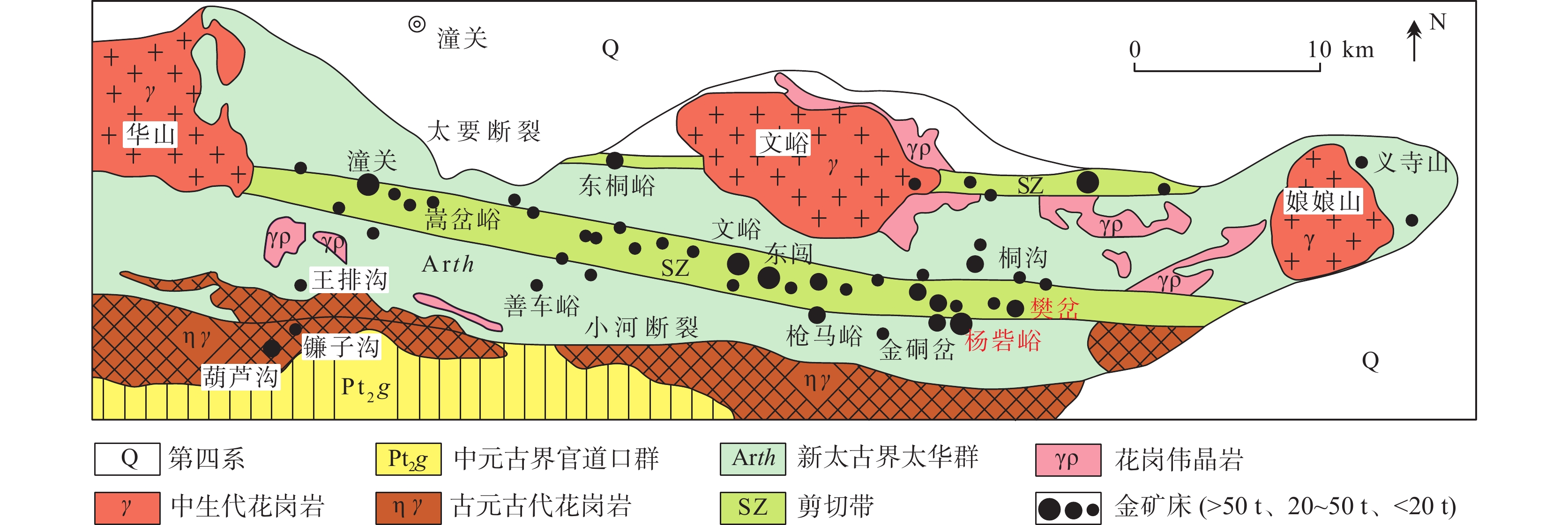
 下载:
下载:
